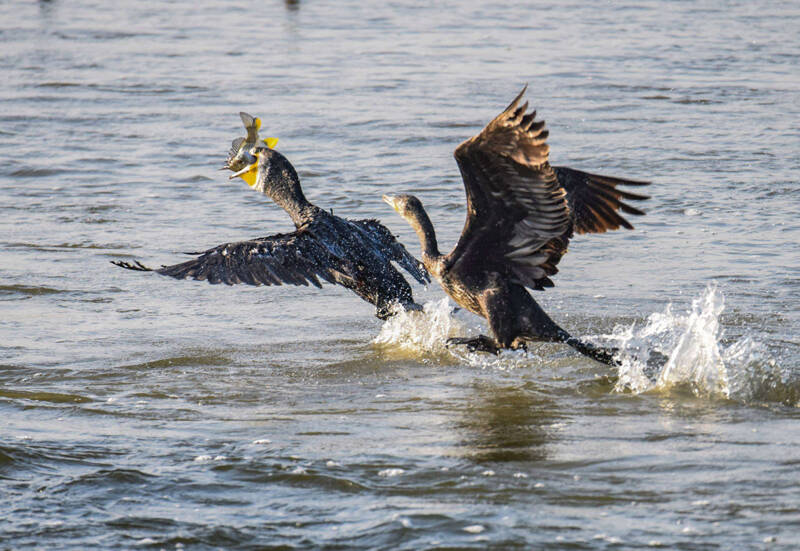Phalacrocorax pelagicus
IUCN
LCBasic Information
Scientific classification
- name:Phalacrocorax pelagicus
- Scientific Name:Phalacrocorax pelagicus,Pelagic Cormorant,Black Pelican
- Outline:Waterfowl
- Family:Pelecaniformes Cormorants Phalacrocorax
Vital signs
- length:72-78.8cm
- Weight:1.18-2.2kg
- lifetime:5-10years
Feature
Good at cooperation, strong in diving and fishing, and very flexible in water
Distribution and Habitat
Sea cormorants are distributed along the coast of the North Pacific Ocean and adjacent islands, from Wrangel Island on the coast of the East Siberian Sea in Russia and the Chukotka Peninsula on the coast of the Chukchi Sea through the Bering Strait to Sakhalin Island, the Kuril Islands, Japan and the Liaodong Peninsula of China, as well as from Alaska and the Aleutian Islands in North America to Baja California.
Origin: Canada, China, Japan, the Democratic People's Republic of Korea, South Korea, Mexico, the Russian Federation, and the United States.
Sea cormorants mainly inhabit near-land islands and coastal areas in temperate oceans, and are also found in estuaries and bays. They often rest in groups on reefs exposed to the sea and on protruding parts of coastal cliffs, as well as on rock tops and cliffs. Sometimes as many as dozens of them stand densely on a small piece of reef. They move in hidden coastal seawater bays and estuaries, and also in the wide sea, nesting on
Appearance
The feathers on the whole body are black, with a purple glow on the head and neck, and a green glow on other parts. During the breeding period, there is a bunch of copper-green crown feathers on the head and pillow, and there are feathers on the forehead. The shoulder feathers and coverts are copper-green. The other two flanks each have a large white spot, and the throat and eyes are exposed. The skin is dark red. The bare skin of the face and throat is brown with small orange bumps. The iris is green. The mouth is relatively slender and slightly flattened on the side. The inside of the mouth base and around the eyes are reddish brown. The two sides of the mouth groove are like inlaid with two sharp blades, extremely sharp, dark brown, and the legs are short, thick, and black. There are 12 black tail feathers in round shape.
The color of winter feathers is basically similar to that of summer feathers, but there is no crest on the head, and there are no white fine feathers on the nec
Details
Pelagic Cormorant is a large water bird with two subspecies.

Most of the sea cormorants are resident birds, active near the breeding grounds all year round, and a few populations that breed in the north need to fly to the warm waters in the south to overwinter. The time of migration often depends on the change of temperature. Usually, they arrive at the breeding grounds soon after the ice and snow in the north begin to melt, and migrate south after the water surface is partially frozen in autumn.
Cormorants mainly feed on various fish, shrimps and other crustaceans. They also eat a small amount of seaweed, kelp, sea laver, etc.
Cormorants have a certain ability to fly, but they are clumsy when walking on the ground, and they need to use hard tail feathers to help support when resting. However, they have very strong diving and fishing abilities, and are very flexible in the water. For them, it is easy to dive 1-3 meters underwater (up to 10 meters deep) and track schools of fish for 30-45 seconds (up to 70 seconds).
When active, cormorants often fly low over the sea surface, or swim in the sea near the islands, and frequently dive into the water to find food. Sometimes a few individuals can be seen in the swamps and bubbles near the coast. The main way to find food is to dive and chase prey underwater. Sometimes they often stand on rocks waiting for the arrival of bait. When resting, if disturbed, they will fly up quickly and spit out the undigested fish bones, fish scales and other food in their stomachs with a mucus sac to reduce weight and speed up flight so as to quickly escape from enemies. At this time, flocks of seagulls will follow closely and eat these food residues one by one, "recycling waste".
Cormorants are a very cooperative water bird. They often gather in large groups to hunt fish in the lake, and the cooperation between the upper and lower levels is very good. It is said that when a cormorant encounters a big fish and is unable to subdue it, it will fight while calling for help from its companions. When nearby cormorants hear the cry for help, they will immediately rush over and attack the big fish together. When foraging in the water, cormorants are also very good at cooperation: sometimes they will cooperate with pelicans to hunt, forming a semicircle on the water surface, with the pelicans flapping their wings on the water surface to drive away the fish, while the cormorants dive into the water to hunt, and both can catch enough food.
Cormorants were once common and common in coastal areas and nearby islands in China, but due to human interference and deteriorating environmental conditions, the population has been greatly reduced. According to the 1992 Asian Midwinter Waterbird Survey, only 246 were seen in China.
Listed in the IUCN Red List of Threatened Species in 2018 ver 3.1 - Least Concern (LC).
China's Red Book of Endangered Animals: Not Listed, Effective Year: 1996
Listed in China's National Key Protected Wildlife List (February 5, 2021) Level 2.
Protect wild animals and stop eating game.
Maintaining ecological balance is everyone's responsibility!








